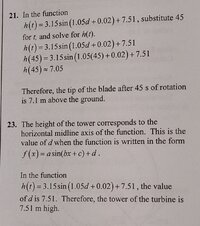Hi all. I'm currently having trouble with sinusoidal functions when I'm using the TI-84 Plus calculator.
I was taught that the equation of a sinusoidal function is y = a sin b (x - c) + d, however, when I use SinReg on the TI-84 Plus calculator, the formula is listed as y = a*sin(bx+c)+d.
I am confused about "c" when it is a negative. If the calculator spits out a negative number with "c", does that mean the equation for that problem is turned into y = a sin b (x + c) + d?
I have two example problems here with conflicting sinusoidal regression equations.
Ex 1. The following table shows the number of hours of daylight for an area in {location} on certain days of the year 2011.
Q: What is a sine regression function that gives the number of hours of daylight, H(d), with respect to the day number, d, of the year 2011? Round the values of a, c and to the nearest hundredth and round the value for b to the nearest thousandth.
The sine regression function given in the book is H(d) = 4.23sin(0.017d - 1.30) + 12.12.
Ex 2:
A wind turbine has four blades mounted on a concrete tower. The following table shows the height of the tip of one of the blades of the turbine as it turns through two rotations.
Q: What is a sine function that represents the height above the ground, h(t), of the tip of the blade with respect to time, t, in seconds? Round the values of a, b, c and d to the nearest hundredth.
The sine regression function given in the book is h(t) = 3.15sin(1.05d + 0.02) + 7.51.
Both example problems gave negative "c" answers, yet one problem has c being added to b and the other is subtracted from b. What is the correct answer here and moving forward, when asked to find sine regression functions on the calculator, if the value of "c" is negative, what would the sine regression function look like?
Thanks.
I was taught that the equation of a sinusoidal function is y = a sin b (x - c) + d, however, when I use SinReg on the TI-84 Plus calculator, the formula is listed as y = a*sin(bx+c)+d.
I am confused about "c" when it is a negative. If the calculator spits out a negative number with "c", does that mean the equation for that problem is turned into y = a sin b (x + c) + d?
I have two example problems here with conflicting sinusoidal regression equations.
Ex 1. The following table shows the number of hours of daylight for an area in {location} on certain days of the year 2011.
Date | Day Number | Hours of Daylight |
January 1 | 1 | 8.00 |
February 12 | 43 | 9.87 |
March 15 | 74 | 11.83 |
April 27 | 117 | 14.59 |
May 8 | 128 | 15.20 |
June 28 | 179 | 16.53 |
July 18 | 199 | 16.00 |
August 10 | 222 | 14.87 |
September 8 | 251 | 13.10 |
October 17 | 290 | 10.62 |
November 6 | 310 | 9.42 |
December 22 | 356 | 7.90 |
Q: What is a sine regression function that gives the number of hours of daylight, H(d), with respect to the day number, d, of the year 2011? Round the values of a, c and to the nearest hundredth and round the value for b to the nearest thousandth.
The sine regression function given in the book is H(d) = 4.23sin(0.017d - 1.30) + 12.12.
Ex 2:
A wind turbine has four blades mounted on a concrete tower. The following table shows the height of the tip of one of the blades of the turbine as it turns through two rotations.
Time (s) | Height (m) |
1 | 10.2 |
2.5 | 9.1 |
4 | 4.8 |
5.5 | 5.9 |
7.5 | 10.7 |
9 | 7.5 |
10.5 | 4.4 |
Q: What is a sine function that represents the height above the ground, h(t), of the tip of the blade with respect to time, t, in seconds? Round the values of a, b, c and d to the nearest hundredth.
The sine regression function given in the book is h(t) = 3.15sin(1.05d + 0.02) + 7.51.
Both example problems gave negative "c" answers, yet one problem has c being added to b and the other is subtracted from b. What is the correct answer here and moving forward, when asked to find sine regression functions on the calculator, if the value of "c" is negative, what would the sine regression function look like?
Thanks.

